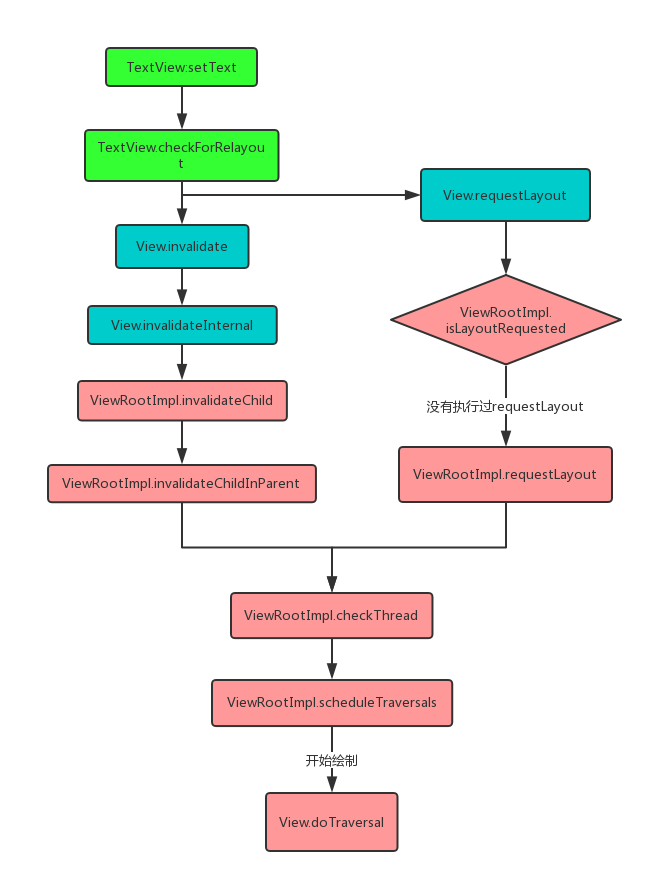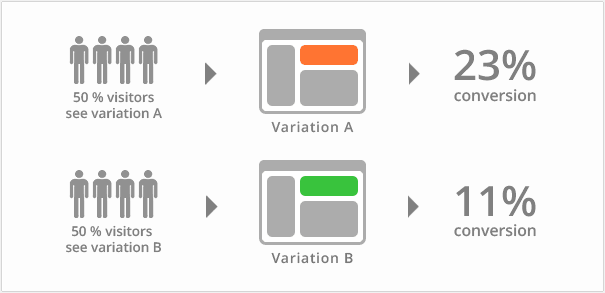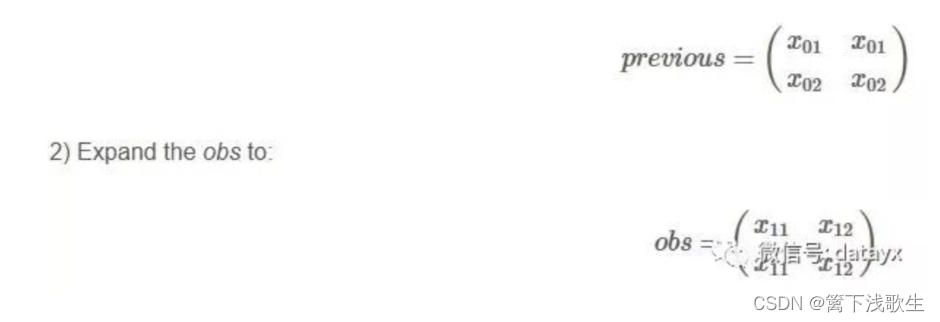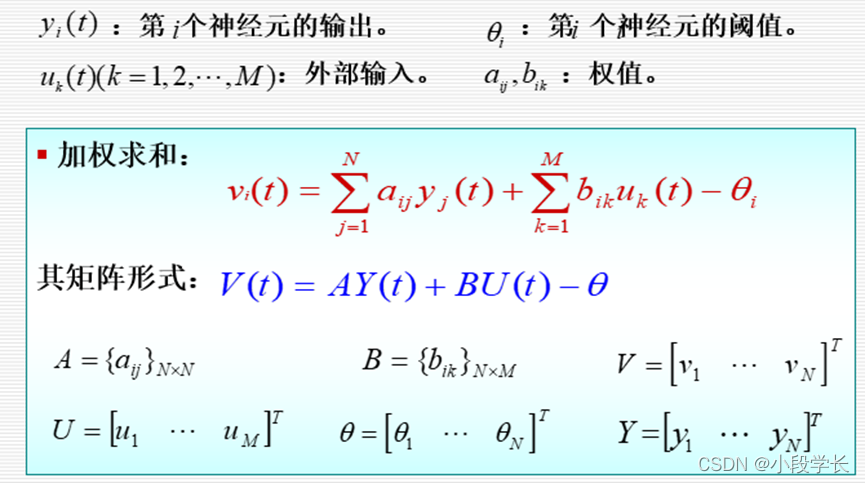
UI change
It was said in the last issue app Not every one vsync All the signals can be received , Only when the application needs to draw , Will pass scheduledVsync? Method application VSYNC The signal .
Let's start with the need to draw , When we changed UI after , It will be carried out invalidate Method to draw , Here's an example setText Method , Let's review the changes UI The flow of time :

You can see , Finally, the parent layout is called ViewRootImpl Of scheduleTraversals Method .
public ViewRootImpl(Context context, Display display) {
//...
mChoreographer = Choreographer.getInstance();
}
void scheduleTraversals() {
if (!mTraversalScheduled) {
mTraversalScheduled = true;
mTraversalBarrier = mHandler.getLooper().getQueue().postSyncBarrier();
mChoreographer.postCallback(
Choreographer.CALLBACK_TRAVERSAL, mTraversalRunnable, null);
//...
}
}
For easy viewing , I just left the relevant code . You can see , stay ViewRootImpl In the construction method , Instantiate Choreographer object , And find out UI It's called when it changes scheduleTraversals In the method , Called postSyncBarrier Method inserts a synchronization barrier , And then it calls postCallback Method , And there's a mTraversalRunnable( It's useful in the back , Pay attention first ), I don't know what this method is for now . Keep looking. .
Choreographer Instantiation
//Choreographer.java
public static Choreographer getInstance() {
return sThreadInstance.get();
}
private static final
《 A big factory Java Analysis of interview questions + Back end development learning notes + The latest architecture explanation video + Practical project source code handout 》 Free open source Prestige search official account 【 Advanced programming 】
ThreadLocal<Choreographer> sThreadInstance =
new ThreadLocal<Choreographer>() {
@Override
protected Choreographer initialValue() {
Looper looper = Looper.myLooper();
//...
Choreographer choreographer = new Choreographer(looper, VSYNC_SOURCE_APP);
//...
return choreographer;
}
};
private Choreographer(Looper looper, int vsyncSource) {
mLooper = looper;
mHandler = new FrameHandler(looper);
// initialization FrameDisplayEventReceiver
mDisplayEventReceiver = USE_VSYNC
? new FrameDisplayEventReceiver(looper, vsyncSource)
: null;
mLastFrameTimeNanos = Long.MIN_VALUE;
// One frame interval
mFrameIntervalNanos = (long)(1000000000 / getRefreshRate());
mCallbackQueues = new CallbackQueue[CALLBACK_LAST + 1];
for (int i = 0; i <= CALLBACK_LAST; i++) {
mCallbackQueues[i] = new CallbackQueue();
}
}
ThreadLocal, Is it a little familiar with ? I said before Handler When I said ,Handler How to get the current thread Looper Of ? Through this ThreadLocal, Again , It's also used here ThreadLocal To ensure that each thread corresponds to a Choreographer.
The storage method is the same , With ThreadLocal by key,Choreographer by value Store in ThreadLocalMap in , Unfamiliar friends can turn to 《Handler Three other difficult questions 》 have a look .
So the mHandler Namely ViewRootImpl Of the thread in which it is located handler. Then look at postCallback What did you do .
postCallback
private void postCallbackDelayedInternal(int callbackType,
Object action, Object token, long delayMillis) {
if (DEBUG_FRAMES) {
Log.d(TAG, "PostCallback: type=" + callbackType
}
synchronized (mLock) {
final long now = SystemClock.uptimeMillis();
final long dueTime = now + delayMillis;
mCallbackQueues[callbackType].addCallbackLocked(dueTime, action, token);
if (dueTime <= now) {
scheduleFrameLocked(now);
} else {
Message msg = mHandler.obtainMessage(MSG_DO_SCHEDULE_CALLBACK, action);
msg.arg1 = callbackType;
msg.setAsynchronous(true);
mHandler.sendMessageAtTime(msg, dueTime);
}
}
}
private final class FrameHandler extends Handler {
public FrameHandler(Looper looper) {
super(looper);
}
@Override
public void handleMessage(Message msg) {
switch (msg.what) {
case MSG_DO_FRAME:
doFrame(System.nanoTime(), 0);
break;
case MSG_DO_SCHEDULE_VSYNC:
doScheduleVsync();
break;
case MSG_DO_SCHEDULE_CALLBACK:
doScheduleCallback(msg.arg1);
break;
}
}
}
void doScheduleCallback(int callbackType) {
synchronized (mLock) {
if (!mFrameScheduled) {
final long now = SystemClock.uptimeMillis();
if (mCallbackQueues[callbackType].hasDueCallbacksLocked(now)) {
scheduleFrameLocked(now);
}
}
}
}
stay ViewRootImpl Called in postCallback After method , You can see through addCallbackLocked Method , Added a CallbackRecord data , among action It's before correspondence ViewRootImpl Of mTraversalRunnable.
Then judge whether the set time is after the current time , That is, there is no delay , If there is a delay, send a delay message MSG_DO_SCHEDULE_CALLBACK To Handler Thread , And finally to scheduleFrameLocked Method . If there is no delay , Directly scheduleFrameLocked.
scheduleFrameLocked( Preparation of application VSYNC The signal )
private void scheduleFrameLocked(long now) {
if (!mFrameScheduled) {
mFrameScheduled = true;
if (USE_VSYNC) {
// Whether to run in the main thread
if (isRunningOnLooperThreadLocked()) {
scheduleVsyncLocked();
} else {
// adopt Handler Switching thread
Message msg = mHandler.obtainMessage(MSG_DO_SCHEDULE_VSYNC);
msg.setAsynchronous(true);
mHandler.sendMessageAtFrontOfQueue(msg);
}
} else {
// Calculate the time of the next frame
final long nextFrameTime = Math.max(
mLastFrameTimeNanos / TimeUtils.NANOS_PER_MS + sFrameDelay, now);
Message msg = mHandler.obtainMessage(MSG_DO_FRAME);
msg.setAsynchronous(true);
mHandler.sendMessageAtTime(msg, nextFrameTime);
}
}
}
case MSG_DO_FRAME:
doFrame(System.nanoTime(), 0);
break;
case MSG_DO_SCHEDULE_VSYNC:
doScheduleVsync();
break;
void doScheduleVsync() {
synchronized (mLock) {
if (mFrameScheduled) {
scheduleVsyncLocked();
}
}
}
In this method , First of all, we judge whether it is on or not VSYNC( Last section said Android4.1 Then it turns on by default VSYNC), If it's on , Judge whether it is in the main thread , If it's the main thread, it runs scheduleVsyncLocked, If not, switch threads , It will also call scheduleVsyncLocked Method , And this method is the application we mentioned before VSYNC The way to signal .
If it's not on VSYNC, Call directly doFrame Method .
In addition, you can see , We just used Handler When sending a message , They all called. msg.setAsynchronous(true) Method , This method is to set the message to asynchronous . Because we set up synchronization barriers in the beginning , So asynchronous messages are executed first , The asynchronous setting here is to make the message execute at the first time and not be affected by others Handler The impact of the news .
Summary 1
Through the above series of methods , We can get a preliminary logical process :
Choreographer When initializing , Will create a new one corresponding to the current thread Handler object , initialization FrameDisplayEventReceiver, Calculate the time of a frame and a series of initialization work .
When UI When things change , Will be called to ViewRootImpl Of scheduleTraversals Method , This method adds synchronization barrier messages , And called Choreographer Of postCallback How to apply VSYNC The signal .
In the process ,Handler A delayed message was sent , Switched threads , And asynchronous is set for all messages , Make sure you do it first .
Continue to look at scheduleVsyncLocked Method .
scheduleVsyncLocked
private void scheduleVsyncLocked() {
mDisplayEventReceiver.scheduleVsync();
}
public void scheduleVsync() {
if (mReceiverPtr == 0) {
Log.w(TAG, "Attempted to schedule a vertical sync pulse but the display event "
} else {
nativeScheduleVsync(mReceiverPtr);
}
}
The code is simple , It is through FrameDisplayEventReceiver, request native The vertical synchronization signal of the plane VSYNC.
This FrameDisplayEventReceiver Is in Choreographer Instantiated in constructor , Inherited from DisplayEventReceiver, The main thing is to deal with VSYNC And receiving signals .
I just talked about calling nativeScheduleVsync Method application VSYNC The signal , And then when you get it VSYNC When the signal comes back onVsync The method .
onVsync( receive VSYNC The signal )
private final class FrameDisplayEventReceiver extends DisplayEventReceiver
implements Runnable {
@Override
public void onVsync(long timestampNanos, long physicalDisplayId, int frame) {
//...
mTimestampNanos = timestampNanos;
mFrame = frame;
Message msg = Message.obtain(mHandler, this);
msg.setAsynchronous(true);
mHandler.sendMessageAtTime(msg, timestampNanos / TimeUtils.NANOS_PER_MS);
}
@Override
public void run() {
mHavePendingVsync = false;
doFrame(mTimestampNanos, mFrame);
}
}
It's also through Handler Sent a message , Executed its own Runnable The callback method , That is to say doFrame().
版权声明
本文为[InfoQ]所创,转载请带上原文链接,感谢
https://yzsam.com/2022/04/202204231353209782.html











